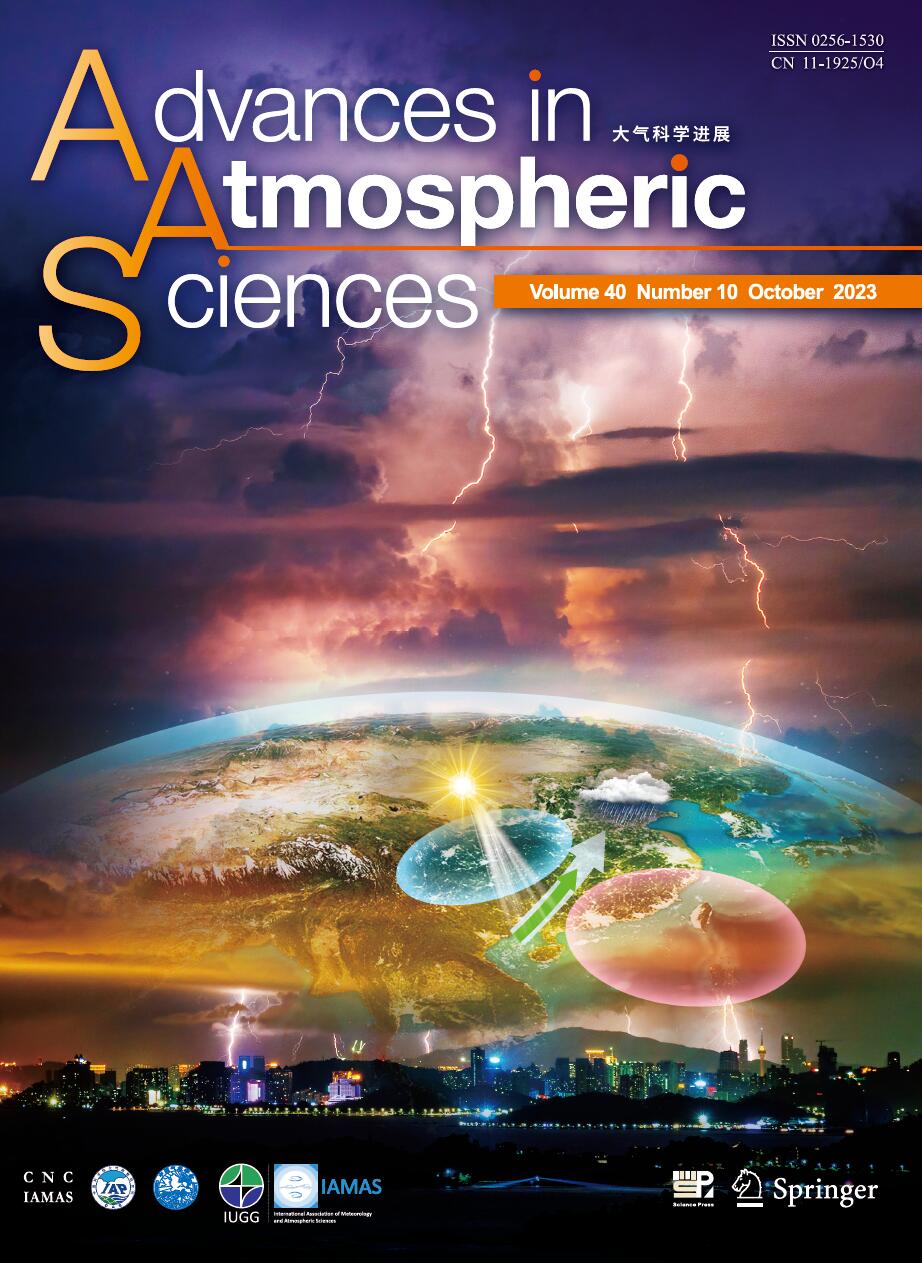| [1] |
Gao Ge, Huang Chaoying,
2001: Climate Change and Its Impact on Water Resources in North China, ADVANCES IN ATMOSPHERIC SCIENCES, 18, 718-732.
doi: 10.1007/BF03403497
|
| [2] |
JIANG Dabang,
2008: Projected Potential Vegetation Change in China under the SRES A2 and B2 Scenarios, ADVANCES IN ATMOSPHERIC SCIENCES, 25, 126-138.
doi: 10.1007/s00376-008-0126-1
|
| [3] |
REN Guoyu, DING Yihui, ZHAO Zongci, ZHENG Jingyun, WU Tongwen, TANG Guoli, XU Ying,
2012: Recent Progress in Studies of Climate Change in China, ADVANCES IN ATMOSPHERIC SCIENCES, 29, 958-977.
doi: 10.1007/s00376-012-1200-2
|
| [4] |
ZHANG Lixia* and ZHOU Tianjun, ,
2014: An Assessment of Improvements in Global Monsoon Precipitation Simulation in FGOALS-s2, ADVANCES IN ATMOSPHERIC SCIENCES, 31, 165-178.
doi: 10.1007/s00376-013-2164-6
|
| [5] |
ZENG Heqing, JIA Gensuo,
2013: Impacts of Snow Cover on Vegetation Phenology in the Arctic from Satellite Data, ADVANCES IN ATMOSPHERIC SCIENCES, 30, 1421-1432.
doi: 10.1007/s00376-012-2173-x
|
| [6] |
Dai Xiaosu, Ding Yihui,
1994: A Modeling Study of Climate Change and Its Implication for Agriculture in China Part II: The Implication of Climate Change for Agriculture in China, ADVANCES IN ATMOSPHERIC SCIENCES, 11, 499-506.
doi: 10.1007/BF02658171
|
| [7] |
DING Yihui, REN Guoyu, ZHAO Zongci, XU Ying, LUO Yong, LI Qiaoping, ZHANG Jin,
2007: Detection, Causes and Projection of Climate Change over China: An Overview of Recent Progress, ADVANCES IN ATMOSPHERIC SCIENCES, 24, 954-971.
doi: 10.1007/s00376-007-0954-4
|
| [8] |
Xue Feng, Zeng Qingcun,
1999: Diagnostic Study on Seasonality and Interannual Variability of Wind Field, ADVANCES IN ATMOSPHERIC SCIENCES, 16, 537-543.
doi: 10.1007/s00376-999-0029-9
|
| [9] |
SONG Lianchun, A. J. CANNON, P. H. WHITFIELD,
2007: Changes in Seasonal Patterns of Temperature and Precipitation in China During 1971--2000, ADVANCES IN ATMOSPHERIC SCIENCES, 24, 459-473.
doi: 10.1007/s00376-007-0459-1
|
| [10] |
GUAN Zhaoyong, LU Chuhan, MEI Shilong, CONG Jing,
2010: Seasonality of Interannual Inter-hemispheric Oscillations over the Past Five Decades, ADVANCES IN ATMOSPHERIC SCIENCES, 27, 1043-1050.
doi: 10.1007/s00376-009-9126-z
|
| [11] |
XU Yongfu, HUANG Yao, LI Yangchun,
2012: Summary of Recent Climate Change Studies on the Carbon and Nitrogen Cycles in the Terrestrial Ecosystem and Ocean in China, ADVANCES IN ATMOSPHERIC SCIENCES, 29, 1027-1047.
doi: 10.1007/s00376-012-1206-9
|
| [12] |
LIANG Feng, TAO Shiyan, WEI Jie, BUEH Cholaw,
2011: Variation in Summer Rainfall in North China during the Period 1956--2007 and Links with Atmospheric Circulation, ADVANCES IN ATMOSPHERIC SCIENCES, 28, 363-374.
doi: 10.1007/s00376-010-9220-2
|
| [13] |
ZHANG Wen, HUANG Yao, SUN Wenjuan, YU Yongqiang,
2007: Simulating Crop Net Primary Production in China from 2000 to 2050 by Linking the Crop-C model with a FGOALS's Model Climate Change Scenario, ADVANCES IN ATMOSPHERIC SCIENCES, 24, 845-854.
doi: 10.1007/s00376-007-0845-8
|
| [14] |
Hu Zengzhen, Tsuyoshi Nitta,
1997: Seasonality of the Interaction between Convection over the Western Pacific and General Circulation in the Northern Hemisphere, ADVANCES IN ATMOSPHERIC SCIENCES, 14, 541-553.
doi: 10.1007/s00376-997-0072-3
|
| [15] |
HAN Zuoqiang, YAN Zhongwei*, LI Zhen, LIU Weidong, and WANG Yingchun,
2014: Impact of Urbanization on Low-Temperature Precipitation in Beijing during 19602008, ADVANCES IN ATMOSPHERIC SCIENCES, 31, 48-56.
doi: 10.1007/s00376-013-2211-3
|
| [16] |
Xuexu WU, Minghuai WANG, Delong ZHAO, Daniel ROSENFELD, Yannian ZHU, Yuanmou DU, Wei ZHOU, Ping TIAN, Jiujiang SHENG, Fei WANG, Deping DING,
2022: The Microphysical Characteristics of Wintertime Cold Clouds in North China, ADVANCES IN ATMOSPHERIC SCIENCES, 39, 2056-2070.
doi: 10.1007/s00376-022-1274-4
|
| [17] |
Xiujing YU, Guoyu REN, Panfeng ZHANG, Jingbiao HU, Ning LIU, Jianping LI, Chenchen ZHANG,
2020: Extreme Temperature Change of the Last 110 Years in Changchun, Northeast China, ADVANCES IN ATMOSPHERIC SCIENCES, 37, 347-358.
doi: 10.1007/s00376-020-9165-z
|
| [18] |
REN Baohua, LU Riyu, XIAO Ziniu,
2004: A Possible Linkage in the Interdecadal Variability of Rainfall over North China and the Sahel, ADVANCES IN ATMOSPHERIC SCIENCES, 21, 699-707.
doi: 10.1007/BF02916367
|
| [19] |
LIN Wenshi, Cholaw BUEH,
2006: The Cloud Processes of a Simulated Moderate Snowfall Event in North China, ADVANCES IN ATMOSPHERIC SCIENCES, 23, 235-242.
doi: 10.1007/s00376-006-0235-7
|
| [20] |
Dongxu YANG, Yi LIU, Hartmut BOESCH, Lu YAO, Antonio DI NOIA, Zhaonan CAI, Naimeng LU, Daren LYU, Maohua WANG, Jing WANG, Zengshan YIN, Yuquan ZHENG,
2021: A New TanSat XCO2 Global Product towards Climate Studies, ADVANCES IN ATMOSPHERIC SCIENCES, 38, 8-11.
doi: 10.1007/s00376-020-0297-y
|















 AAS Website
AAS Website 
 AAS WeChat
AAS WeChat 
 DownLoad:
DownLoad: